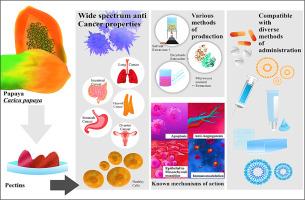Therapeutic potential, formulation strategies and cancer treatment applications of ripe papaya pectin (Carica papaya L.): A comprehensive review
IF 6.5
Q1 CHEMISTRY, APPLIED
Carbohydrate Polymer Technologies and Applications
Pub Date : 2025-07-11
DOI:10.1016/j.carpta.2025.100942
引用次数: 0
Abstract
This review presents a critical appraisal of ripe papaya pectin (Carica papaya L.) (RPP) as a multifaceted biopolymer for cancer treatment, highlighting its structural complexity, bioactivity, and pharmaceutical potential. RPP, with its high molecular weight polysaccharide composition of galacturonic acid and homogalacturonan rhamnogalacturonan domains, possesses significant antitumor activity through galectin-3 inhibition, activation of caspase-3, and immunomodulatory release of cytokines. The review examines cutting-edge extraction techniques, i.e., microwave-assisted extraction (MAE), enzymatic hydrolysis, and solvent systems and how they extensively influence the molecular weight distribution (20–150 kDa), methylation level, and bioavailability. This review recognizes major formulation challenges to the clinical usefulness of ripe papaya pectin (RPP), specifically to delivering pH-responsive, target-specific drug release with low systemic toxicity. RPP-derived nanocarriers micelles, hydrogels, and liposomes exhibit improved cellular uptake, sustained release, and physicochemical stability. Methods such as FTIR, HPLC, and NMR reveal structural properties associated with therapeutic performance. Preclinical experiments validate RPP's selective cytotoxicity against tumour cells with minimal effect on healthy tissue. This paper suggests that RPP, optimally tailored through biofunctionalization and refined delivery design, spans nutraceutical potential and oncological use, and presents robust translational capacity as a low-toxicity, biocompatible foundation in future cancer therapeutics.

成熟木瓜果胶的治疗潜力、配方策略及抗癌应用综述
本文综述了成熟木瓜果胶(Carica papaya L.) (RPP)作为一种用于癌症治疗的多方面生物聚合物,重点介绍了其结构复杂性、生物活性和药物潜力。RPP具有高分子量的半乳糖醛酸和鼠李糖半乳糖醛酸结构域的多糖组成,通过抑制半乳糖凝集素-3、激活caspase-3和免疫调节细胞因子的释放,具有显著的抗肿瘤活性。本文综述了先进的提取技术,即微波辅助提取(MAE)、酶解和溶剂系统,以及它们如何广泛影响分子量分布(20-150 kDa)、甲基化水平和生物利用度。这篇综述认识到成熟木瓜果胶(RPP)的临床有效性面临的主要配方挑战,特别是在提供ph响应性,靶向性药物释放和低全身毒性方面。rpp衍生的纳米载体胶束、水凝胶和脂质体表现出更好的细胞摄取、持续释放和物理化学稳定性。FTIR, HPLC和NMR等方法揭示了与治疗性能相关的结构特性。临床前实验验证了RPP对肿瘤细胞的选择性细胞毒性,对健康组织的影响最小。本文认为,通过生物功能化和精细的递送设计,RPP可以跨越营养保健和肿瘤学应用的潜力,并具有强大的转化能力,作为未来癌症治疗的低毒性、生物相容性基础。
本文章由计算机程序翻译,如有差异,请以英文原文为准。
求助全文
约1分钟内获得全文
求助全文

 求助内容:
求助内容: 应助结果提醒方式:
应助结果提醒方式:


